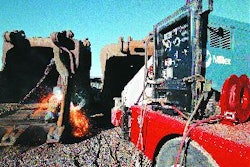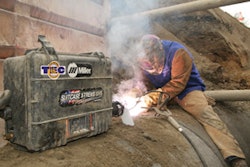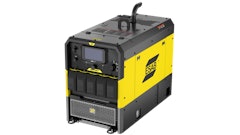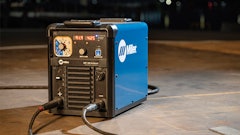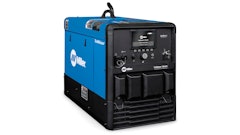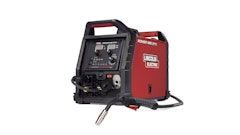
Engine-driven welders are typically used when electric power isn't available, such as for outdoor jobs where it often is not convenient to supply electric power. Many of these outdoor applications, including maintenance and equipment repair, require welders that are easy to transport. Compact tube frame welders with small gasoline engines are an ideal choice. Models with an enclosed case, although considered portable, are significantly heavier at 200 to 300 lbs. Tube frame engine-driven welders are more easily lifted by hand or with a crane from the back of a pick-up truck right to the jobsite. They are ideal for contractors, maintenance crews, farmers and ranchers.
If you're looking to purchase a portable engine-driven welder for your next jobsite, this article will help identify what key features to consider when selecting a tube frame welder for your welding and repair needs.
Key Features to Look for in Tube Frame Welders
AC or DC Welding Output Options
Before looking at advanced features, you'll first have to determine if an AC or a DC welder is the best power source for your needs.
Machines with AC welding output are typically available at a lower price than machines with DC welding output. This is due to the elimination of electrical components needed to convert AC welding current to DC welding current. They are lighter and easier to transport than DC models. These machines are great for equipment or field repair and work best with stick electrodes designed for an AC welding output. Engine-driven AC welders are also great for powering a grinder or other small power tools from the AC generator power.
DC engine-driven welders require additional electrical components to convert AC welding current to DC welding current, but give operators a wider range of stick electrodes for a variety of applications. DC welders are also preferred for the smooth DC welding output and arc delivery when welding steel, stainless steel, cast iron or even hardfacing applications.
For both AC and DC welders, 1/8" electrode is the most common diameter, although 3/32" and 5/32" diameters are also popular. The 1/8" electrode typically requires a machine with 125 to 140 amps of output, whereas the 5/32" diameter typically requires 150 to 170 amps.
Once you've chosen either an AC or a DC welder, there are a few more features you'll need to consider.
Durable Frame
One of the most important elements for any outdoor equipment is that it have a durable, protective tube frame. You will want to make sure the protective tubes are large in diameter, rugged and sturdy. This provides added durability and adequate protection for the entire machine.
Engines
Look for a commercial-grade engine with a cast iron cylinder liner and at least a two-year warranty from the manufacturer. A cast iron cylinder liner is the key to a long engine life. Other features offered in slightly higher-end models include an engine idler and electric start options.
Electric start
Electric start is an important feature for larger gasoline engines, especially those above 10 horsepower. This is because they can be more difficult to pull-start, especially when mounted to a truck. Welders with accessible electric start capabilities are easier and more convenient to start.
Engine idler
An engine idler reduces noise and saves fuel. A machine with an idle function slows the engine speed significantly after a weld is completed or the use of the AC generator power stops. The welder idles to the slower speed usually within 10 to 15 seconds. This feature means you will need to refuel less often and the slower speed can help extend the life of your engine and reduce operational noise.
Run time and fuel tank size
Run time capabilities are important for performing larger, more time-intensive jobs. Since run time versus idle time affects the rate of fuel consumption, choose a welder with a large fuel tank, such as one that holds more than five gallons. A larger tank will allow for extended run times with less frequent refueling and increased efficiency.
Easy access controls
When working from a truck and using a welder with the electric start feature mentioned above, the best arrangement is for all the engine controls to be on the front of the machine for easy access. This includes the start switch and the engine choke control.
Manual transport
Look for features and accessories that make transporting your welder easy. Some engine drives, such as Lincoln Electric's Outback 185 and Outback 145, have Low-Lift grab bars that provide more leverage for lifting these welders on and off truck beds.
An accessory that can make your welder more portable is an undercarriage with foam-filled, puncture- proof tires, and fold-down, non-slip handles with built-in cable holders. An undercarriage makes it easier to control and wheel the tube frame welder to different areas on the jobsite. The foam-filled, puncture-proof tires will hold up when rolling over sharp objects such as nails or pieces of sharp metal. The fold-down handles are great for saving storage space, and the cable holders provide convenience for wrapping welding cables for storage.
Warranty
But before buying any welder, you should make sure the machine and the engine have at least a two- to three-year warranty. Typically they are each warranted by their separate manufacturers, so check that the warranties are for the same duration to ensure the life of your welder and engine as one unit.
For more information on welding applications and products, visit www.lincolnelectric.com or contact your local welding distributor.




